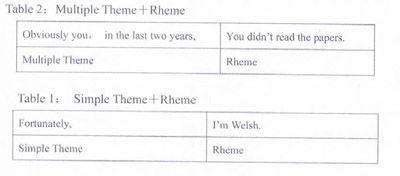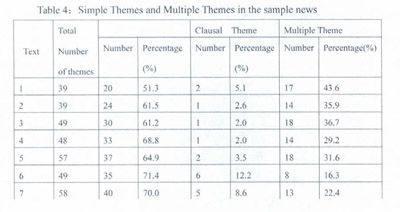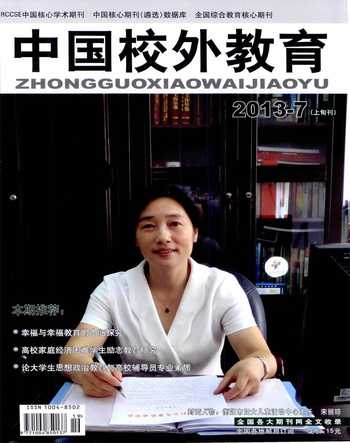Theme—Rheme Analysis of English Sports News
Zou Shuli



As a functional style,sports news English has aroused attention and concern of the stylists. This thesis chooses the report of 2011 Winbledon Games by New York Times and The Sun. This paper analyzes the style characteristics of theme Rheme system from the aspect of text function, with the purpose of helping people to know more about the writing techniques of English Newspapers.
English sport news Theme Rheme
1. Thematic Structure
The terms “Theme” and “Rheme” are two important conception in systematic function, which were first put forward by Mathesius, a Czech linguist, in his article “On Functional Sentence Perspective”. He has proposed this idea to study what different functions of different components of sentence play in the language communication.
In his terminology, Theme refers to that which is known or at least obvious in the given situation and from which the speaker precedes, and Rheme refers to what the speaker states about, or in regard to, the starting point of the utterance.
Hallidayan approach differentiate from Prague approach in that it separate the thematic and information structure, though often overlapping features of text organization.
Halliday developed part of Mathesius's definition into his own:
The Theme is the element which serves as the point of departure of the message; it is that which the clause is concerned. The remainder of the message, the part in which the Theme is developed, is called in Prague school terminology the Rheme.
A message consists of a Theme and a Rheme. In Hallidayan terminology, the configuration Theme+Rheme is either called “Theme/Rheme structure,” or “Thematic structure” or “Theme structure”.
Within the configuration, the Theme is the starting-point for the message; it is the ground from which the clause is taking off, so it can be said that part of the meaning of any clause lies in which element is chosen as its Theme.
With different criterion, there are different ways to distinguish themes.
From the point of view of the elements embodying in the thematic structure, the theme can be divided into interpersonal theme, experiential theme and textual theme.
There are simple Theme, multiple Theme and clausal Theme from the perspective of the thematic structure itself.
If the theme contains only the experiential elements, we call it simple theme, if the theme contains interpersonal and textual elements besides experiential ones, then we call it multiple theme.
In addition, a dependent clause taken as the point of departure for the whole clause complex is called clausal Theme. Clausal Theme is also one of the simple Theme. Let's look at the following examples:
2. Simple Theme and Multiple Theme
According to the functional structure and constituent of the theme, the theme was divided into three categories by Halliday, they are:simple theme, multiple theme, and clausal theme.
The clausal theme also can be categorized to simple theme. In this case the theme is performed by a clause, so the theme has its own thematic structure.
A simple theme cannot be divided further since it has only one structural element, whereas a multiple theme has a further, internal structure of its own. The internal structure of a multiple theme include three elements:experiential element, textual element and interpersonal element. These three kinds of elements correspond to the three components of Halliday's theory of metafunctions discussed above. Since a participant in thematic function corresponds fairly closely to topic, Experiential element regarded as topical theme according to Halliday's theory. The other two are the textual theme, interpersonal theme respectively.
The present thesis will adopt the classification of two types of themes. Since clausal theme plays basically the role of adjunct in a clause, the present thesis treats it as a kind of adjunct in analyzing the news text.
According to Hu Zhuangli, simple theme can be embodied by two forms.
Firstly, it doesn't mean that it only consists of one phrase. Several phrases together forming a phrase complex or a nominal group, as long as it is one element, it can also be called a simple theme. It can be a nominal phrase, adverbial phrase or prepositional phrase.
E.g. The girl in the red (T)// came here quietly.
For a cup a tea (T)// he get into this room.
Slowly and quietly (T)// she get near to her mother.
Secondly, the clausal theme also can be classified as simple theme. In this case the theme is performed by a clause, so the theme itself has its own thematic structure.
E.g. When the bough breaks, the cradle will fall.
Before analyze multiple theme, first let's look at following examples:
1) a. But no man has been living as dangerously at Wimbledon this year as Gilles Simon.
2) a. Possibly no man has been living as dangerously at Wimbledon this year as Gilles Simon.
3) a. But possibly no man has been living as dangerously at Wimbledon this year as Gilles Simon.
In the above sentences, there are other elements before topical theme/experiential theme, which make sentences analysis more difficult. Therefore, Halliday put forward the concept of multiple theme, "the Theme extends from the beginning of the clause up to the first element that has a function in transitivity". Further, Huang Guowen pointed out "a clause only should have a topical/experiential theme which means ideational function". A multiple theme sentence is that there are textual theme or interpersonal theme before topical/experiential theme. Usually, the continuous words "yes, no, well, now", the conjunction words "but, and, yet, when, however" or relational word "which" are served as textual theme.
The interpersonal theme acted by the following words: the mood adjunct "possibly, surely, probably", the address before topical/experiential theme such as "Bob, Tom", the finite constituent in interrogative sentence such as "can, may, whose book".
The sequential of Multiple theme is carried by "textual theme + topical/experiential theme、interpersonal theme + topical/experiential theme、textual theme + interpersonal theme + topical/experiential theme”.
Therefore, the theme of the above examples can be divided as follows:
1) a. But(textual theme) no man(topical/experiential theme)// has been living as dangerously at Wimbledon this year as Gilles Simon(Rheme).
2) a. Possibly(interpersonal theme) no man(topical/experiential theme)// has been living as dangerously at Wimbledon this year as Gilles Simon(Rheme).
3) a. But (textual theme) possibly (interpersonal theme) no man (topical/experiential theme)// has been living as dangerously at Wimbledon this year as Gilles Simon(Rheme).
In the theme sentence structure, sometimes there can be lack of textual theme or interpersonal theme. In additional, if the textual or interpersonal elements put after the topical/experiential theme, they are no longer the textual theme or interpersonal theme, but belongs to rheme.
3. Conclusion
This conclusion devoted to presenting the general summary of the whole thesis. By means of analyzing the news in The Sun and The NewYork Times from the perspective of thematic structure, thematic progression, information structure and cohesive devices, we finally arrive at the following findings.
Simple theme mainly used in English Sports News, textual theme and topical theme are the main type of multiple theme used in English Sports News, interpersonal themes seldom appeared.
It indicates that multiple Themes in this type of texts are used more to realize the cohesion of the text than to complement the interpersonal meaning of the text. In sports news, textual Theme is usually used to show the logical relationship such as adversative, additive, causal and temporal and so on, which can help to describe events and present the inner connection among events.
In a word, Theme system used in sports news can realized the mode of sports news as a written text to be read.
参考文献:
[1]Bloor, T&Bloor,M.The Functional Analysis of English: A Hallidayan Approach. Beijing: Foreign Language Teaching and Research Press,2001.
[2]Halliday, M. A. K. An Introduction to Functional Grammar. Peking: Foreign Language Teaching and Research Press.,2000.
[3] Thompson, Geoff. Introducing Functional Grammar. London: Edward Arnold, 2000.
[4]黄衍.试论英语主位和述位.外国语,1985.10-16.
[5]徐有志.英语文体学教程.北京:高等教育出版社,2005.
[6]徐盛桓.主位和述位.外语教学与研究,1982. 1-9.
[7]徐盛桓.再论主述和述位.外语教学与研究,1985.19-25.
[8]朱永生.主位推进模式与语篇分析.外语教学与研究,995.6-12.
[9]朱永生.主位与信息分布.外语教学与研究,1990.23-27.

